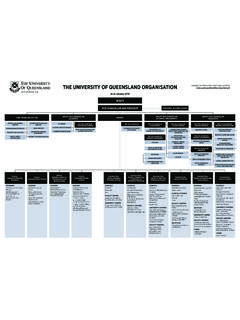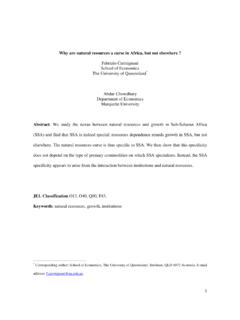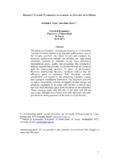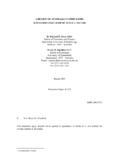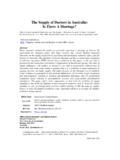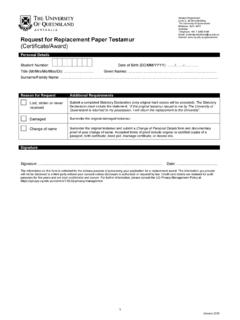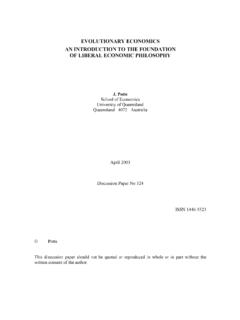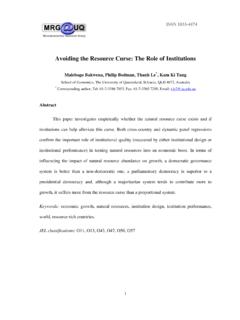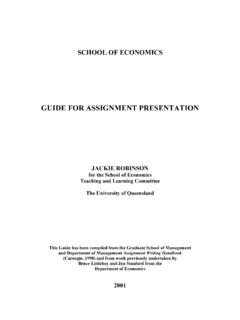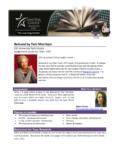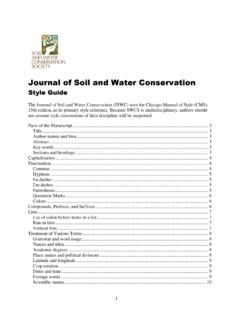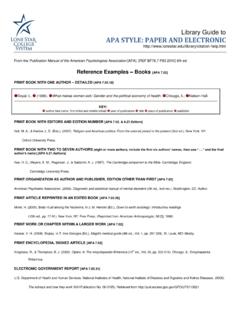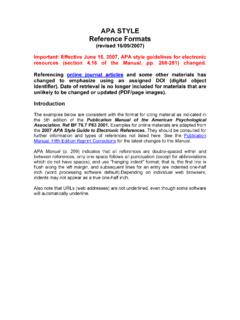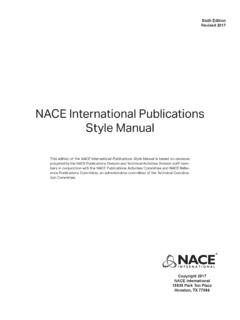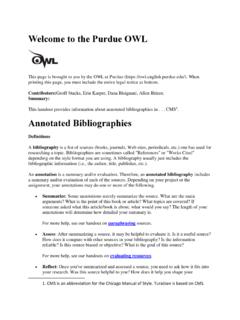Transcription of Chicago Citation and Format Style Guide - uq.edu.au
1 Chicago Citation and Format Style Guide This Guide introduces the Chicago Format and provides examples of Citation styles you might use in research papers. Additional examples and explanations may be found in The Chicago Manual of Style : The Essential Guide for Writers, Editors and Publishers, Fifteenth Edition ( 2003), available at the reference desk. The Chicago Style and Format is extremely similar to the Format of Turabian s A Manual for Writers of Term Papers, Theses and Dissertations, Sixth Edition, revised by John Grossman and Alice Bennett ( 1996 available in the circulating stacks and at the reference desk). CONTENTS Which subject areas use the Chicago standard? What is the basic Format of the academic paper? Parenthetical Reference system of Citation explained Use of Footnotes and Endnotes explained Citations in all formats Format for citing electronic sources Links to other Chicago Citation guides Which subject areas use the Chicago standard?
2 Chicago may be used in any class or course of study, including the humanities, social sciences, and natural sciences. Many people use Chicago as a catchall, for instance, when they do not know which Style Format their professor prefers. It is always best to find out from your professor which Style he or she prefers. If this is not possible, at least be consistent in choosing one Style of presenting bibliographic information and using it throughout your paper. What is the basic Format of the academic paper? The academic paper is separated into three parts: (1) the front matter (title page, copyright page, dedication and/or epigraph, table of contents, lists of illustrations/tables, acknowledgments, abstract, etc.); (2) the body of the paper, the text; and (3) the back or reference matter (appendixes, endnotes, bibliography or references, glossary, index, etc.). The text of the research paper should be double-spaced, with the exception of indented block quotes, which can be single-spaced.
3 Bibliographies, footnotes, and itemized lists should also be single spaced. All pages count in a numbering system, although some pages, like the title page or dedication page, may not actually have numbers printed on them. Pages considered front matter (except the title page) should be numbered with consecutive lower case roman numerals in the bottom center. The rest should be numbered with Arabic numerals (ex: 1, 3, 14). Number the first page of text, and other pages with titles, in the bottom center, and number all other pages (including the back matter) in the top center or upper right corner. Chicago Format also sets guidelines for the use of numbers in the body of a text. Numbers referring to pages, chapters, parts, volumes, and other divisions of a book, as well as numbers referring to illustrations or tables, are set as numerals. References to volumes, issues, and pages of a journal are typically made, in the order described, with Arabic numerals.
4 The words volume and page are typically omitted (ex: His article appeared in the Journal of Religion 79, no. 1 (1999): 19-53. ). Also, ordinal numbers should be spelled out when referring to successive governing bodies if the number is one hundred or less (ex: Ninety-seventh Congress, 107th Congress). This same rule applies to political and judicial divisions (ex: Twelfth Congressional District); military units (ex: 101st Airborne Division); places of worship (ex: Fourth Presbyterian Church); numbered streets (ex: First Avenue, 122nd Street). Abbreviations can be used in parenthetical reference and in the body of the text. When repeatedly citing a source, or a number of sources by the same author, you should devise an appropriate abbreviation and consistently use that abbreviation throughout the paper. An appropriate abbreviation should reflect the title of the work: for example, Much Ado About Nothing can be abbreviated as MAN.
5 If you use many abbreviations, you should include a list of abbreviations in either the front or back matter of your work. Abbreviations are used in the body of the text most frequently in the sciences; outside of these areas, they appear most frequently in tabular matter, notes, bibliographies, and parenthetical references. Abbreviations should be used only in a context that can be understood by the reader. For example, DNA is almost never mentioned in its spelled-out form, and in most contexts can safely be used without explanation. However, when using less common abbreviations (ex: HMO) that may not be understood by all readers, they should be spelled out at their first occurrence. If you have a question about the standard Format of an abbreviation (for example, the proper abbreviation for weight or mass ), you should consult Chapter 15 of the Chicago Manual of Style . In the humanities and social sciences in general, abbreviations in the body of the text should be avoided.
6 The Chicago Manual of Style also spells out rules and conventions for chapter headings and subheadings, designations of tables, and the like, and there is simply no substitute for consulting the manual directly for advice on these issues. Finally, recognizing that this manual may be used in any discipline, The Chicago Manual of Style offers advice on different systems of Citation Style . For literature, arts, and history, Chicago recommends the bibliographic system, using footnotes or endnotes supplemented by a bibliography or reference list. For the physical, natural, and social sciences, Chicago recommends the parenthetical system, or author- date system with corresponding reference list (see below, or see chapter 16 of The Chicago Manual). However, the Style you choose should be consistent with your professors instructions: some professors in the humanities prefer the parenthetical system of reference to the more formal bibliographic system.
7 Parenthetical reference system of Citation explained The parenthetical system of reference, alternatively called the author- date system, has in recent years become the most widely-used system of reference in the natural and social sciences, and is also frequently used in the humanities. This system places, within the text of the paper, a reference to a different work within a set of parentheses. The parentheses contain the author of that referenced work (or compiler, translator, or editor), its date of publication, and a page reference, if appropriate. Each source represented by a parenthetical reference within the text must be included in the Reference List or Bibliography. The Reference List entry will be a complete bibliographic Citation , including author, title, source, publisher and date of publication. Chicago advises that while Reference Lists and Bibliographies are similar in Format and content, they are not identical.
8 A Bibliography is used in the footnote/endnote system to provide an overview of the sources used by the author, and can include both cited works and other relevant sources. It is an addendum meant to simplify for the reader all the cited works in a paper, but is not completely necessary given that the footnote/endnote system should offer the full bibliographic details as part of the note. It is, however, recommended by most professors to include a Bibliography as part of a completed paper. A Reference List can be alternatively titled References or Works Cited. It is used as the second, necessary half of the author- date (parenthetical) system. As the author- date system uses abridged textual references, the Reference List is necessary to identify the source of these brief citations. In this way, the Reference List is considered the prime vehicle for documentation, while the textual references merely point to the location of the full Citation .
9 The Chicago Manual advises that, while the author- date system is often preferred because of its simplicity, it is best used when all the references cited can be converted to author- date formats. If you are working with manuscript collections, anonymous works, or other sources less easily converted, it is best to use the footnote/endnote system, which will allow you more opportunity to immediately identify these sources for your reader. Footnotes and endnotes explained Notes have four basic purposes: (1) to cite authority for statements made in the text; (2) to make cross-references; (3) to amplify, qualify, or comment on material in the text that would break up the flow of the text if included there; and (4) to make acknowledgements. The first two purposes define reference notes, the last two, content notes. Note numbers should be placed in the text following the passage requiring it, in Arabic superscript (a half space above the line).
10 In current versions of Microsoft Word, selecting Insert, followed by Reference, followed by Footnote will automatically set up your superscript number, as well as automatically place the footnotes in numerical order for you. After you select the Footnote function you have the option to change from footnotes to endnotes if you prefer that Style . Numbers should be in numerical order beginning with 1. Corresponding footnotes should be placed at the bottom of the page containing the footnote reference, separated from the text by a separator, a short line made by underscoring. Footnotes can begin with a superscript number or a regular number on the same line of the text (preferred by Chicago ). If a superscript is used, there needn t be a space between it and the body of the note. If an on-line numeral is used, a period and a space should follow it. The first author s family name comes before his or her given name in a bibliography; subsequent contributing author s names are not inverted.
